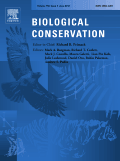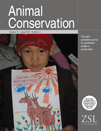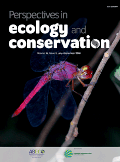
BIOLOGICAL CONSERVATION
Scope & Guideline
Fostering Innovative Solutions for Ecological Challenges.
Introduction
Aims and Scopes
- Biodiversity Assessment and Monitoring:
The journal publishes research on methodologies for assessing biodiversity, including species distribution, population dynamics, and the impacts of conservation measures on species and ecosystems. - Conservation Strategies and Policies:
Papers often explore the effectiveness of various conservation strategies, including protected area management, community-based conservation, and policy frameworks that support biodiversity. - Ecological Restoration and Management:
Research on ecological restoration practices, including habitat rehabilitation, species reintroduction, and the management of invasive species, is a consistent focus. - Human-Wildlife Interactions:
The journal addresses the complexities of human-wildlife interactions, including conflict resolution and the socio-economic factors influencing conservation outcomes. - Climate Change and Conservation:
Studies examining the impact of climate change on biodiversity and the development of adaptive management strategies are prevalent, reflecting the urgent need for conservation in a changing environment. - Ethics and Conservation:
An emphasis on ethical considerations in conservation practices, including the role of indigenous knowledge and the implications of conservation actions on local communities.
Trending and Emerging
- Community-Based Conservation:
There is a growing trend towards research that emphasizes community engagement and the role of local stakeholders in conservation efforts, highlighting the importance of social dimensions in biodiversity management. - Integrative Conservation Approaches:
Emerging themes include integrative conservation strategies that blend ecological, social, and economic perspectives, reflecting a shift towards holistic solutions for complex conservation challenges. - Climate Adaptation Strategies:
Research on adaptation strategies to mitigate the effects of climate change on biodiversity is increasingly prevalent, underlining the urgent need for proactive conservation measures. - Technological Innovations in Conservation:
The use of technology, such as remote sensing, eDNA analysis, and machine learning, is gaining traction in conservation research, facilitating more effective monitoring and management practices. - Cultural and Ethical Dimensions of Conservation:
Emerging studies are focusing on the ethical implications of conservation practices, including the integration of indigenous knowledge and values, which are becoming central to contemporary conservation discussions. - Urban Biodiversity and Green Spaces:
Research examining biodiversity in urban environments and the role of green spaces in promoting wildlife conservation is trending, reflecting global urbanization patterns and their ecological implications.
Declining or Waning
- Species-Specific Conservation:
There appears to be a waning emphasis on species-specific conservation efforts, as more research is directed towards ecosystem-wide approaches and the conservation of functional groups rather than individual species. - Traditional Ex Situ Conservation:
Studies focusing on traditional ex situ conservation methods, such as captive breeding, have become less prominent as the field shifts towards more integrative and landscape-level conservation strategies. - Single-Species Management:
Research concentrating solely on single-species management has decreased, with a growing recognition of the need for holistic approaches that consider ecological interactions and community dynamics. - Invasive Species Management:
While still important, the frequency of papers specifically targeting invasive species management has declined as conservation strategies increasingly incorporate broader ecological frameworks. - Biodiversity Offsetting:
The concept of biodiversity offsetting, once a significant focus, has seen reduced attention as critiques of its effectiveness and ethical implications have emerged, leading to calls for more sustainable and integrated conservation practices.
Similar Journals

Floresta e Ambiente
Exploring the ecological significance of forests worldwide.Floresta e Ambiente is a pioneering open-access journal dedicated to advancing knowledge in forestry and environmental science, published by the Federal Rural University of Rio de Janeiro's Institute of Forests. Since its inception in 2012, this journal has emerged as a crucial platform for researchers, professionals, and students to disseminate innovative findings and foster discussions on sustainable forest management, conservation practices, and the ecological significance of forests in Brazil and beyond. With an impressive impact factor and a commendable ranking in the SCOPUS database, positioned in the 49th percentile of the Agricultural and Biological Sciences category, Floresta e Ambiente actively supports the dissemination of high-quality research while contributing to the global discourse on forestry. As an open access journal since 2013, it ensures that valuable knowledge is readily available to all, enhancing collaboration and engagement within the scientific community.

AMPHIBIAN & REPTILE CONSERVATION
Preserving Nature's Wonders Through Innovative ResearchAMPHIBIAN & REPTILE CONSERVATION, published by the Amphibian Conservation Research Center & Lab, is a leading journal dedicated to the field of herpetology and environmental conservation. With an ISSN of 1083-446X and an E-ISSN of 1525-9153, this journal serves as a vital resource for researchers, conservationists, and students interested in the preservation of amphibian and reptile species. The journal has achieved remarkable rankings, categorized in the Q2 quartile for Animal Science and Zoology, Ecology, and Nature and Landscape Conservation as of 2023, reflecting its significant contribution to the scientific community. Over the converged years from 2016 to 2024, the journal has established itself as an integral platform for disseminating research findings, fostering collaboration, and enhancing the understanding of biodiversity and ecosystem dynamics. By embracing an open-access approach, AMPHIBIAN & REPTILE CONSERVATION ensures that critical research is readily available to a global audience, promoting informed conservation efforts and policy advocacy to safeguard these vital species amidst their declining populations.

ANIMAL CONSERVATION
Uniting Voices for Global Conservation Efforts.Animal Conservation is a prestigious journal that serves as a vital platform for the dissemination of research dedicated to the preservation of wildlife and habitats. Published by Wiley, this journal has established a significant presence in the fields of Ecology and Nature and Landscape Conservation, holding a distinguished Q1 category ranking for both in 2023. With an impressive Scopus rank of #25 in the realm of environmental science, it caters to a global audience keen on understanding and addressing pressing conservation issues. The journal provides researchers, professionals, and students with high-quality, peer-reviewed articles that explore innovative methods and strategies in animal conservation. With its continuous publication since 1998, encompassing a comprehensive range of topics, Animal Conservation is indispensable for anyone aiming to make impactful contributions to the field of ecology and conservation biology.

PACIFIC CONSERVATION BIOLOGY
Fostering innovative strategies for a sustainable future in conservation.PACIFIC CONSERVATION BIOLOGY is an esteemed academic journal published by CSIRO PUBLISHING, dedicated to advancing research in the fields of ecology and nature conservation. With a strong focus on the unique challenges and biodiversity of the Pacific region, this journal serves as a crucial platform for researchers, conservationists, and students alike to disseminate high-quality, impactful findings. Operating from Australia, it has become a significant resource since its inception in 1993, navigating through nearly three decades of vital scholarly communication. Ranked in the Q2 category for both Ecology and Nature and Landscape Conservation as of 2023, PACIFIC CONSERVATION BIOLOGY maintains rigorous standards, as reflected in its successful Scopus rankings. The journal plays a pivotal role in addressing pressing ecological issues and fostering innovative conservation strategies, making it an essential reference for anyone involved in environmental science. Access options for the journal facilitate widespread distribution of knowledge, supporting the mission to promote informed decision-making in conservation practices.

Tropical Life Sciences Research
Illuminating the Path of Tropical Life Sciences DiscoveryTropical Life Sciences Research, published by PENERBIT UNIVERSITI SAINS MALAYSIA, is an esteemed open-access journal dedicated to the realms of Agricultural and Biological Sciences, Biochemistry, Genetics, and Molecular Biology, and Medicine. Since its inception in 2006, this journal has established itself as a significant platform for disseminating high-quality research findings that contribute to the understanding of tropical biodiversity and health-related issues. With its innovative approach, Tropical Life Sciences Research has garnered an impressive impact factor, reflecting its influence in the academic community; it is ranked Q2 in Agricultural and Biological Sciences and Q3 in both Biochemistry and Medicine categories as of 2023. Researchers and professionals can access a wealth of knowledge through this journal, whose content spans from 2009 to 2024, making it a vital resource for students and experts alike interested in advancing the science of tropical ecosystems and health. The journal also stands out for its comprehensive Scopus rankings, indicating its relevance and quality in the competitive academic landscape.

Conservation Letters
Shaping Effective Strategies for Global Biodiversity PreservationConservation Letters, published by Wiley, is a premier peer-reviewed journal dedicated to advancing the field of conservation science. As an Open Access journal since 2015, it provides researchers, practitioners, and policymakers with immediate access to cutting-edge research and insights that shape effective conservation strategies globally. With an impressive impact factor and a distinguished standing in the academic community—ranking in the Q1 category in disciplines such as Ecology, Evolution, and Nature Conservation—the journal plays a vital role in disseminating high-quality research that informs environmental practices. Based in the United States, it encompasses a broad scope of topics aimed at bridging scientific findings with real-world applications, effectively contributing to the understanding and preservation of biodiversity. Researchers looking to publish innovative work in an influential platform will find Conservation Letters an essential venue for ensuring their research reaches an engaged international audience.

NEW ZEALAND JOURNAL OF ECOLOGY
Exploring New Zealand's Ecological FrontiersNEW ZEALAND JOURNAL OF ECOLOGY, published by the New Zealand Ecological Society, stands as a premier platform for disseminating research in the field of ecology, with a notable impact factor reflected in its Q2 ranking in multiple ecology categories for 2023. Established in 1980 and actively publishing since 1982, this journal provides a vital resource for ecologists and environmental scientists, fostering the exchange of innovative ideas and methodologies. The journal covers a wide range of ecological topics, ensuring a comprehensive overview of the current trends and research developments in both ecological theory and practical applications specific to New Zealand and beyond. Researchers, professionals, and students will find in this journal an authoritative source to advance their understanding of ecological dynamics and contribute to the growing field of ecological science. The journal is accessible to the community without open access, providing critical insights that underpin the ecological landscape of New Zealand and inform sustainable practices worldwide.

Diversity-Basel
Advancing biodiversity research for a sustainable future.Diversity-Basel is a premier open-access journal published by MDPI, specializing in the vital fields of agricultural, biological, and ecological sciences. Launched in 2009, this multidisciplinary journal, operating from Switzerland, aims to disseminate high-quality research that advances the understanding of biodiversity and ecosystem dynamics. With an impressive impact factor and notable rankings in Scopus, including Q1 classification in Agricultural and Biological Sciences and strong positions in Ecology and Ecological Modeling, Diversity-Basel stands as a valuable resource for global researchers, professionals, and students alike. Its commitment to accessibility enables researchers to reach a wider audience, fostering collaboration and innovation in addressing pressing environmental challenges. By providing an inclusive platform for diverse scientific inquiries and innovations, Diversity-Basel plays an essential role in shaping the discourse on biodiversity conservation and management, encouraging the pursuit of sustainable solutions in our rapidly changing world.

Perspectives in Ecology and Conservation
Fostering knowledge exchange in the realm of ecology and conservation.Perspectives in Ecology and Conservation, published by Elsevier Science Ltd, is a leading academic journal dedicated to advancing the fields of ecology, conservation, and environmental management. With a Q1 ranking in multiple categories, including Ecology, Management, Monitoring, Policy and Law, and Nature and Landscape Conservation, this journal boasts an impressive standing among its peers, making it essential reading for researchers and professionals. Since its inception in 2017 and running through 2024, it aims to provide innovative perspectives and critical analyses that enhance our understanding and practices in conservation science. The journal is accessible through open access options, facilitating broader dissemination of knowledge. Its commitment to addressing contemporary ecological challenges reinforces its importance in the academic community, promoting sustainable practices and informed policy-making in the face of urgent environmental issues.

NORTHWEST SCIENCE
Cultivating knowledge for a sustainable future in environmental sciences.NORTHWEST SCIENCE, published by the NORTHWEST SCIENTIFIC ASSOCIATION, serves as a vital resource for researchers and professionals in the fields of ecology, evolution, and systematics. With an ISSN of 0029-344X and an E-ISSN of 2161-9859, this journal has been disseminating valuable scientific insights since its inception in 1975 and continues to do so into 2024. Although currently positioned in the Q4 quartile for its category, it plays a crucial role in advancing the understanding of ecological and biological sciences, reflecting a diverse range of studies and methodologies. Researchers will find the journal particularly appealing due to its emphasis on regional studies and their implications on a global scale. While NORTHWEST SCIENCE is not an open-access publication, it provides significant contributions to the academic dialogue within its discipline, making it an essential addition to the library of any dedicated researcher, student, or professional in the environmental sciences.